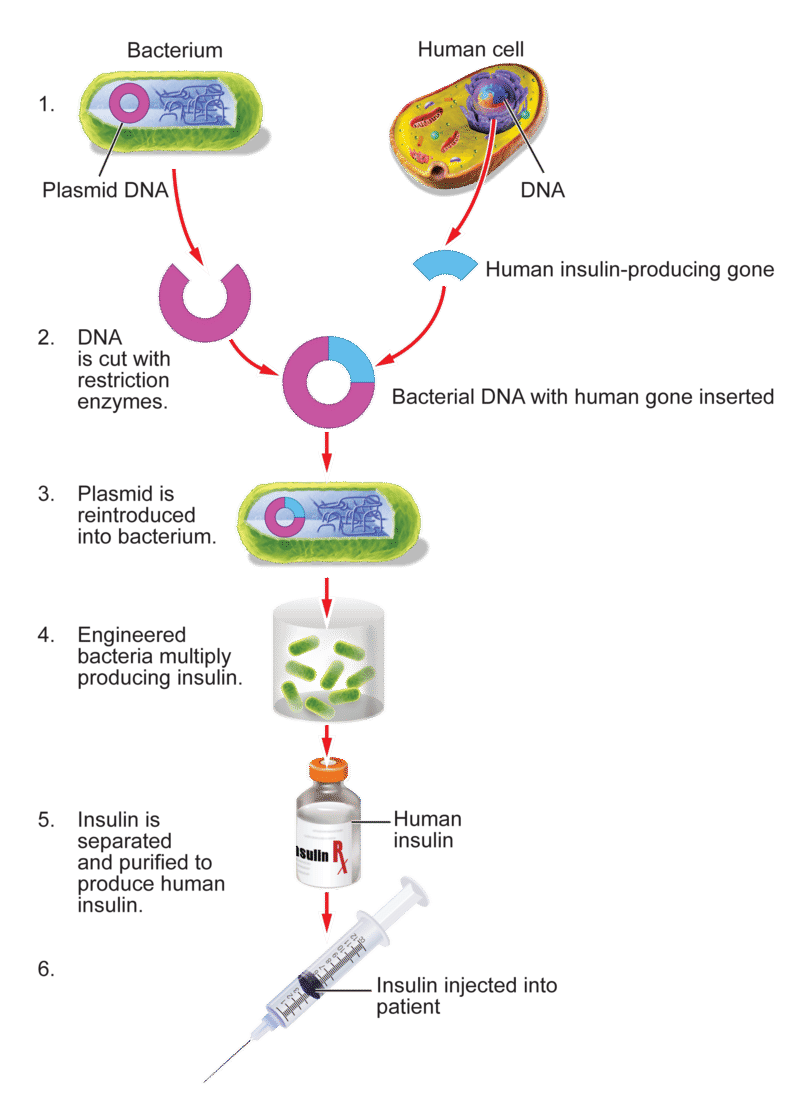Genetically Engineered Human Insulin Is Used to Treat Which Disease
Current uses of genetic engineering. Four years after the first clinical trials it appears that there are only minor pharmacokinetic differences from.

Genetic Engineering Ck 12 Foundation
It used to stimulate allergic reactions and other immune responses due to its foreign origin in some people.

. In this study the murine enteroendocrine cell line STC-1 was genetically modified by stable transfection. Engineering these good bacteria to alter the activity of genes gone awry either by turning them down or by activating them is a promising approach to improve health and combat diseases. The research and application of genetic engineering has generated much debate and controversy.
Genetic engineering aims to modify the genes to enhance the capabilities of the organism beyond what is normal. Gene therapy seeks to alter genes to correct genetic defects and thus prevent or cure genetic diseases. Recombinant DNA technology was used to produce large-scale quantities of human insulin in E.
Type 1 diabetes is a disorder in which the bodys pancreas does not produce enough insulin. It may also be used in the treatment of type 2 diabetes if insulin levels remain low despite the use of other types of medications although most people with type 2 diabetes do not require insulin in the early stages of the disease. There are usually no conventional treatments for these.
Insulin is used in the treatment of people with type 1 diabetes who produce little or no insulin. FDA approves the first consumer GMO product developed through genetic engineering. There are discussions about the benefits of such technology as this would allow us to eradicate genetically inherited diseases such as cystic fibrosis and haemophilia.
Human insulin to treat diabetes. Following their discovery virtually all insulin. Coli as early as 1978.
Researchers introduced genetically modified bacteria into mice which reduced glucose and insulin levels and could become a treatment for diseases like diabetes. Previously it was only possible to treat diabetes with pig insulin which caused allergic reactions in humans because of differences in the gene product. In a study published in the journal Nature Communications researchers at Texas AM University have developed a sophisticated programmable gene silencing.
Ethical controversy surrounds possible use of the both of these technologies in plants nonhuman animals and humans. Diabetes is well managed by taking insulin. Genetic engineering has also been important in the production of other therapeutic proteins such as insulin interferons and human growth hormone to treat a variety of human medical conditions.
Many human diseases such as cystic fibrosis Downs syndrome fragile X syndrome Huntingtons disease muscular dystrophy sickle-cell anemia Tay-Sachs disease etc. Genetically engineered insulin is the first application of recombinant DNA technology which has gone into industrial production and wide clinical use. It also meant insulin was part of the earliest wave of biologics a growing field of medicine that is changing the way we treat many autoimmune conditions such as asthma and juvenile arthritis.
The federal government establishes the Coordinated Framework for the. Although pigs are used widely as models of human disease their utility as models has been enhanced by genetic engineering. Diabetes mellitus saving his life and proving insulins efficacy in treating human diabetes.
Initially transgenes were added randomly to the genome but with the application of homologous recombination zinc finger nucleases. Earlier insulin was extracted from the pancreas of killed cattle and pigs. Downstreaming occurs this is when insulin is extracted purified and packaged.
The pure insulin produced can be used to treat diabetes. As we have already touched on genetic engineering is being used to treat some very serious human diseases and disorders like diabetes with insulin. Advantages of genetically engineered insulin.
Matthew Chang a synthetic biologist at the National University of Singapore says that genetically modified bacteria have the potential to treat many types of. The Need for Preparing Genetically Engineered Insulin. For example at one time it was possible to treat diabetes only by giving patients pig insulin which caused allergic reactions due to small.
Insulin has been used for many years to treat diabetes. A gene therapy-based treatment of type 1 diabetes mellitus requires the development of a surrogate beta cell that can synthesize and secrete functionally active insulin in response to physiologically relevant changes in ambient glucose levels. Type 1 diabetes T1D is a chronic autoimmune disease whereby auto-reactive cytotoxic T cells target and destroy insulin-secreting β-cells in pancreatic islets leading to insulin deficiency and subsequent hyperglycemia.

1 What Is Genetic Engineering Labxchange

Gene Therapy Uses Safety Ethics Concerns Uses Genetic Engineering Technique Making Insulin Pros Cons Gm Crops Products Medical Applications Dna Ligase Restriction Enzymes Igcse O Level Gcse 9 1 Biology Revision Notes Examinations

From Insulin To Humulin The Story Of The First Genetically Engineered Drug Genetics Unzipped
Comments
Post a Comment